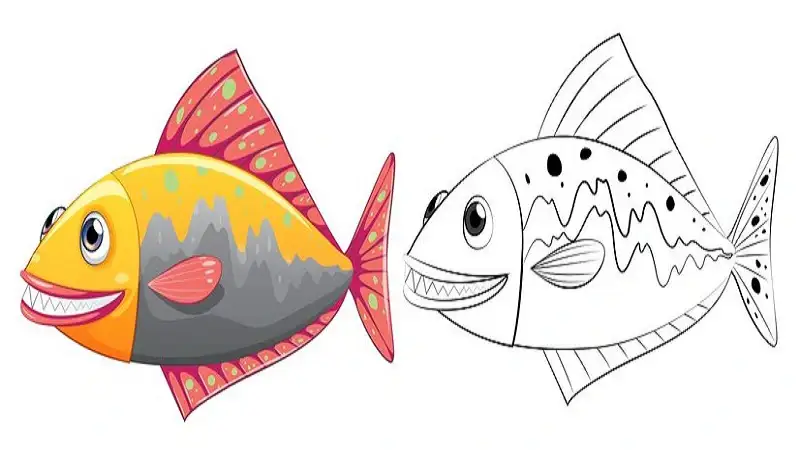Drawing:4o7kwxpryiy= Fish have long been admired for their graceful forms, vibrant colors, and elegant movements. They make excellent subjects for drawing, whether you’re a beginner just getting started or an experienced artist looking to expand your skills. In this guide, we’ll take you through the process of drawing fish step by step, offering tips on anatomy, technique, and creativity.
Introduction to Fish Drawing
Why Fish Are Great Subjects for Drawing
Fish are incredibly diverse in their shapes, sizes, and colors, making them perfect for artists. Their fluid bodies and intricate details, like fins and scales, offer a balance of simplicity and complexity. Fish allow you to play with form, structure, and texture, all while creating something visually interesting.
The Significance of Fish in Art History
Fish have also played a symbolic role in art for centuries, representing everything from fertility to abundance. In various cultures, fish have appeared in religious art, mythology, and folklore, making them timeless and meaningful subjects.
Materials You’ll Need
Choosing the Right Drawing Tools
Before you dive into Drawing:4o7kwxpryiy= Fish, it’s essential to have the right materials. A solid foundation starts with good tools.
Pencils
You’ll need a range of pencils, from hard (H) pencils for light sketching to softer (B) pencils for shading and deeper lines. A 2H pencil is excellent for light sketching, while a 4B or 6B pencil is perfect for adding shadows and depth.
Paper
Use sketching paper that holds pencil marks well without smudging too easily. Look for paper with a bit of texture, like medium-to-heavyweight drawing paper.
Erasers and Other Essentials
Have a kneaded eraser for softening lines or removing small details without damaging the paper. Additionally, a ruler and a blending stump can help with precision and smooth shading.
Optional Tools to Enhance Your Drawing
Once you’re comfortable with basic tools, you might want to add colored pencils, markers, or even pastels to create more vibrant fish drawings.
Basic Fish Anatomy for Artists
Understanding the Structure of a Fish
To draw a fish accurately, it’s helpful to understand their anatomy. Fish generally have streamlined bodies, fins for movement, a tail for propulsion, and gills for breathing. By keeping these in mind, your drawings will have a more realistic and cohesive structure.
Common Features to Capture
Most fish share common features like an elongated body, lateral fins, and an arched back. Knowing where these elements are typically placed will help you sketch your fish with confidence.
Step-by-Step Guide to Drawing a Fish
Step 1: Sketch the Basic Shape
Start by drawing a simple oval or teardrop shape for the fish’s body. This will serve as the foundation for your drawing.
Step 2: Outline the Fish’s Body
Next, refine the shape, making the head slightly more rounded and tapering the tail end.
Step 3: Add the Fins and Tail
Sketch the dorsal fin on the fish’s back and the pectoral and pelvic fins along the sides. Add the tail (caudal fin) at the rear.
Step 4: Drawing the Details (Scales, Eyes, and Fins)
Draw the Drawing:4o7kwxpryiy= Fish eye near the head and add scale texture along its body by making small, overlapping shapes. Be sure to emphasize the detail in the fins by using curved lines to show the fin rays.
Step 5: Shading and Adding Depth
To make your fish look more lifelike, add shading where light would naturally hit the body. Use darker shading on the underside and lighter on top to mimic underwater lighting.
Advanced Techniques for Drawing Fish
Adding Texture to Fish Scales
Create a realistic texture by varying the size of the scales. Larger scales can go on the body while smaller, finer scales can go near the head and fins.
Creating Movement in Your Drawing
Fish are known for their fluid motion, so try to capture this by drawing the body in a slight curve. This creates the illusion of swimming.
Using Color to Bring Your Fish to Life
Adding color is a fun way to make your fish pop! Use bright blues, oranges, and yellows for tropical fish or more muted tones for freshwater species.
Tips for Drawing Different Types of Fish
Drawing Tropical Fish
Tropical Drawing:4o7kwxpryiy= Fish are known for their bright colors and distinctive patterns. Experiment with bold designs and vibrant hues to replicate their exotic appearance.
Drawing Freshwater Fish
Freshwater fish, like bass or trout, have more subtle coloration. Focus on their unique textures and patterns to make them stand out.
Drawing Sea Creatures Like Sharks and Dolphins
Sharks and dolphins have sleeker bodies. When drawing these creatures, focus on their streamlined forms and powerful fins.
Common Mistakes to Avoid When Drawing Fish
Avoid making the body too rigid or the fins too symmetrical. Fish are fluid and natural, so embrace imperfections to keep them lifelike.
How to Improve Your Fish Drawings Over Time
Practicing Regularly
Consistent practice is key to mastering fish drawing. Set aside time to draw regularly, even if it’s just for a few minutes each day.
Studying Real-Life Fish and Reference Photos
Use photos or videos of fish to study their movement, colors, and shapes. This helps you understand their anatomy and dynamics better.
Learning from Other Artists
Follow fish-drawing tutorials online or take inspiration from other artists’ techniques. This broadens your artistic approach.
Conclusion:
Drawing:4o7kwxpryiy= Fish is not only a fun and creative activity but also a way to sharpen your artistic skills. Whether you’re sketching a simple fish or diving into intricate details and colors, each drawing presents a chance to explore your creativity. The more you practice, the better you’ll become at capturing the beauty and motion of these incredible creatures.
